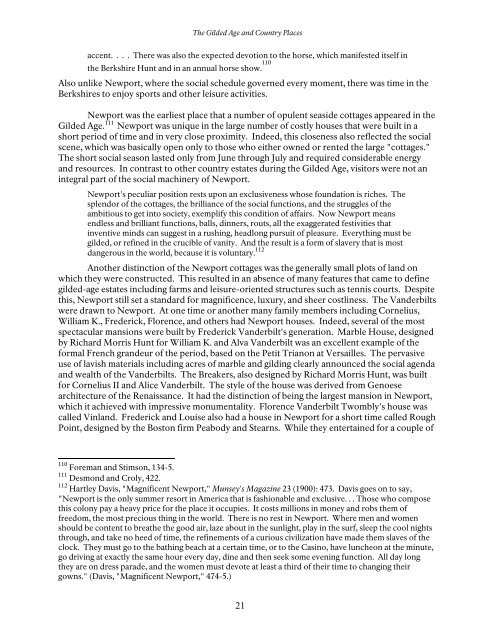National Park Service U.S. Department of the Interior
National Park Service U.S. Department of the Interior
National Park Service U.S. Department of the Interior
Create successful ePaper yourself
Turn your PDF publications into a flip-book with our unique Google optimized e-Paper software.
The Gilded Age and Country Places<br />
accent. . . . There was also <strong>the</strong> expected devotion to <strong>the</strong> horse, which manifested itself in<br />
<strong>the</strong> Berkshire Hunt and in an annual horse show. 110<br />
Also unlike Newport, where <strong>the</strong> social schedule governed every moment, <strong>the</strong>re was time in <strong>the</strong><br />
Berkshires to enjoy sports and o<strong>the</strong>r leisure activities.<br />
Newport was <strong>the</strong> earliest place that a number <strong>of</strong> opulent seaside cottages appeared in <strong>the</strong><br />
Gilded Age. 111 Newport was unique in <strong>the</strong> large number <strong>of</strong> costly houses that were built in a<br />
short period <strong>of</strong> time and in very close proximity. Indeed, this closeness also reflected <strong>the</strong> social<br />
scene, which was basically open only to those who ei<strong>the</strong>r owned or rented <strong>the</strong> large "cottages."<br />
The short social season lasted only from June through July and required considerable energy<br />
and resources. In contrast to o<strong>the</strong>r country estates during <strong>the</strong> Gilded Age, visitors were not an<br />
integral part <strong>of</strong> <strong>the</strong> social machinery <strong>of</strong> Newport.<br />
Newport's peculiar position rests upon an exclusiveness whose foundation is riches. The<br />
splendor <strong>of</strong> <strong>the</strong> cottages, <strong>the</strong> brilliance <strong>of</strong> <strong>the</strong> social functions, and <strong>the</strong> struggles <strong>of</strong> <strong>the</strong><br />
ambitious to get into society, exemplify this condition <strong>of</strong> affairs. Now Newport means<br />
endless and brilliant functions, balls, dinners, routs, all <strong>the</strong> exaggerated festivities that<br />
inventive minds can suggest in a rushing, headlong pursuit <strong>of</strong> pleasure. Everything must be<br />
gilded, or refined in <strong>the</strong> crucible <strong>of</strong> vanity. And <strong>the</strong> result is a form <strong>of</strong> slavery that is most<br />
dangerous in <strong>the</strong> world, because it is voluntary. 112<br />
Ano<strong>the</strong>r distinction <strong>of</strong> <strong>the</strong> Newport cottages was <strong>the</strong> generally small plots <strong>of</strong> land on<br />
which <strong>the</strong>y were constructed. This resulted in an absence <strong>of</strong> many features that came to define<br />
gilded-age estates including farms and leisure-oriented structures such as tennis courts. Despite<br />
this, Newport still set a standard for magnificence, luxury, and sheer costliness. The Vanderbilts<br />
were drawn to Newport. At one time or ano<strong>the</strong>r many family members including Cornelius,<br />
William K., Frederick, Florence, and o<strong>the</strong>rs had Newport houses. Indeed, several <strong>of</strong> <strong>the</strong> most<br />
spectacular mansions were built by Frederick Vanderbilt's generation. Marble House, designed<br />
by Richard Morris Hunt for William K. and Alva Vanderbilt was an excellent example <strong>of</strong> <strong>the</strong><br />
formal French grandeur <strong>of</strong> <strong>the</strong> period, based on <strong>the</strong> Petit Trianon at Versailles. The pervasive<br />
use <strong>of</strong> lavish materials including acres <strong>of</strong> marble and gilding clearly announced <strong>the</strong> social agenda<br />
and wealth <strong>of</strong> <strong>the</strong> Vanderbilts. The Breakers, also designed by Richard Morris Hunt, was built<br />
for Cornelius II and Alice Vanderbilt. The style <strong>of</strong> <strong>the</strong> house was derived from Genoese<br />
architecture <strong>of</strong> <strong>the</strong> Renaissance. It had <strong>the</strong> distinction <strong>of</strong> being <strong>the</strong> largest mansion in Newport,<br />
which it achieved with impressive monumentality. Florence Vanderbilt Twombly's house was<br />
called Vinland. Frederick and Louise also had a house in Newport for a short time called Rough<br />
Point, designed by <strong>the</strong> Boston firm Peabody and Stearns. While <strong>the</strong>y entertained for a couple <strong>of</strong><br />
110 Foreman and Stimson, 134-5.<br />
111 Desmond and Croly, 422.<br />
112 Hartley Davis, "Magnificent Newport," Munsey's Magazine 23 (1900): 473. Davis goes on to say,<br />
"Newport is <strong>the</strong> only summer resort in America that is fashionable and exclusive. . . Those who compose<br />
this colony pay a heavy price for <strong>the</strong> place it occupies. It costs millions in money and robs <strong>the</strong>m <strong>of</strong><br />
freedom, <strong>the</strong> most precious thing in <strong>the</strong> world. There is no rest in Newport. Where men and women<br />
should be content to brea<strong>the</strong> <strong>the</strong> good air, laze about in <strong>the</strong> sunlight, play in <strong>the</strong> surf, sleep <strong>the</strong> cool nights<br />
through, and take no heed <strong>of</strong> time, <strong>the</strong> refinements <strong>of</strong> a curious civilization have made <strong>the</strong>m slaves <strong>of</strong> <strong>the</strong><br />
clock. They must go to <strong>the</strong> bathing beach at a certain time, or to <strong>the</strong> Casino, have luncheon at <strong>the</strong> minute,<br />
go driving at exactly <strong>the</strong> same hour every day, dine and <strong>the</strong>n seek some evening function. All day long<br />
<strong>the</strong>y are on dress parade, and <strong>the</strong> women must devote at least a third <strong>of</strong> <strong>the</strong>ir time to changing <strong>the</strong>ir<br />
gowns." (Davis, "Magnificent Newport," 474-5.)<br />
21

















